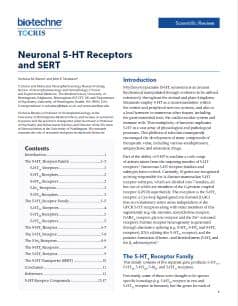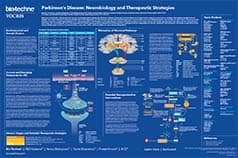5-HT1A Receptors
The serotonin 5-HT1A receptor was the first 5-HT receptor to be fully sequenced. 5-HT1A receptor binding sites are located primarily in limbic brain areas, notably the hypothalamus and cortical areas. The human gene encoding this receptor has been localized to chromosome 5.
5-HT1A Receptor Agonists |
|
|---|---|
| Cat. No. | Product Name / Activity |
| 5584 | Aripiprazole |
| High affinity D2 and 5-HT1A partial agonist; also 5-HT2A antagonist | |
| 1869 | Ipsapirone |
| Selective 5-HT1A agonist | |
| 1746 | Nemonapride |
| 5-HT1A agonist; also highly potent D2-like dopamine antagonist | |
| 0912 | RU 24969 hemisuccinate |
| 5-HT1A and 5-HT1B agonist | |
| 2854 | Tandospirone hydrochloride |
| Selective 5-HT1A partial agonist | |
| 6202 | Vilazodone hydrochloride |
| Potent 5-HT1A partial agonist and SSRI; antidepressant | |
5-HT1A Receptor Antagonists |
|
| Cat. No. | Product Name / Activity |
| 2806 | Alprenolol hydrochloride |
| 5-HT1A antagonist; also β-adrenoceptor antagonist | |
| 0993 | Cyanopindolol hemifumarate |
| 5-HT1A and 5-HT1B antagonist; also β-adrenergic antagonist | |
| 0553 | NAN-190 hydrobromide |
| 5-HT1A antagonist | |
| 1253 | (S)-WAY 100135 dihydrochloride |
| Potent and selective 5-HT1A antagonist | |
| 4380 | WAY 100635 maleate |
| Potent 5-HT1A antagonist; also D4 agonist | |
The serotonin 5-HT1A receptor was the first 5-HT receptor to be fully sequenced and the human gene encoding this receptor has been localized to chromosome 5 (5q11.2-q13).
5-HT1A receptor binding sites are located primarily in limbic brain areas, notably the hypothalamus, lateral septum, cortical areas and the mesencephalic raphe nuclei. 5-HT1A receptor ligands with agonist activity possess antianxiety, antidepressant, antiaggressive, and perhaps anticraving, anticataleptic, antiemetic, and neuroprotective properties.
External sources of pharmacological information for 5-HT1A Receptors :
Literature for 5-HT1A Receptors
Tocris offers the following scientific literature for 5-HT1A Receptors to showcase our products. We invite you to request* your copy today!
*Please note that Tocris will only send literature to established scientific business / institute addresses.
5-HT Receptors Scientific Review
Written by Nicholas M. Barnes and John F. Neumaier, this review summarizes the various serotonin receptor subtypes and their importance in mediating the role of serotonin in numerous physiological and pharmacological processes. Compounds available from Tocris are listed.
Depression Poster
Major depressive disorder is characterized by depressed mood and a loss of interest and/or pleasure. Updated in 2015 this poster highlights presynaptic and postsynaptic targets for the potential treatment of major depressive disorder, as well as outlining the pharmacology of currently approved antidepressant drugs.
Parkinson's Disease Poster
Parkinson's disease (PD) causes chronic disability and is the second most common neurodegenerative condition. This poster outlines the neurobiology of the disease, as well as highlighting current therapeutic treatments for symptomatic PD, and emerging therapeutic strategies to delay PD onset and progression.


